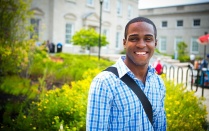Campus News
UB engineering school recognized as national leader in diversity, inclusiveness

Taraunraj Singh (left), professor of mechanical and aerospace engineering, works with students in a research lab in Furnas Hall. Photo: Douglas Levere
By CORY NEALON
Published February 21, 2020
Summer camps for high school girls. Hiring a diversity officer. Strengthening programs that support underrepresented students and faculty.
Those are just a few of the reasons the School of Engineering and Applied Sciences has been recognized by the American Society of Engineering Education (ASEE) as a national leader in diversity and inclusiveness.
“It is a credit to our entire school community that our diversity and inclusion efforts are being recognized nationally, and this award highlights that we are moving in the right direction,” says Rajan Batta, interim dean of the School of Engineering and Applied Sciences.
The school is among 29 engineering programs nationwide in 2019 to receive the bronze award with exemplar status from ASEE’s Diversity Recognition Program.
It was the program’s inaugural year and bronze was the only level available. ASEE granted exemplar status to programs with initiatives or outcomes that were deemed by the reviewers as significant.
“The bronze-level recognition means that your school is among the nation’s leaders” in advancing diversity and inclusion, says Gregory Washington, chair of the ASEE Engineering Deans Council. “I commend you for your progress and thank you for your support of this important” initiative.
Launching new diversity programs
Creating a more diverse and inclusive community has long been a goal of UB’s School of Engineering and Applied Sciences. For years, it led programs such as Buffalo Engineering Awareness for Minorities and Tech Savvy.
The former prepares underrepresented middle and high school students for STEM (science, technology, engineering and mathematics) careers. The latter works to introduce middle school girls to STEM fields in ways that are fun, exciting and relevant to their world.
Another example is the Louis Stokes Alliance for Minority Participation program. This SUNY-led effort, which the school houses, supports historically underrepresented groups such as African Americans, American Indians and Latinos.
In late 2012, the school placed a renewed emphasis on boosting diversity and inclusiveness among students, faculty and staff when Liesl Folks began her tenure as dean. Folks tapped Batta, then serving as associate dean for faculty affairs and diversity, and other leaders to guide the effort.
New programs were launched, including the university’s Women in Science and Engineering program, as well as the Women in STEM Cooperative. Both work toward increasing the success of women in STEM fields; the cooperative hosts an annual summit (now in its sixth year) scheduled for March 4.
Another example is the Women’s Empowerment Scholarship, which is awarded to incoming freshman female students who demonstrate potential to become leaders in engineering or computer science. The non-tuition scholarship, which can help pay for housing, student fees and other costs, is the result of a partnership between the school and the Undergraduate Admissions office.
More women engineering students
The school’s efforts are working.
The percentage of female undergraduate engineering students rose from 14.6% in fall 2014 to 18.3% last autumn. In the same time period, the percentage of female graduate students rose from 21.2% to 24.5%.
Meanwhile, the school is becoming more racially diverse. In the past six years, the percentage of Latino undergraduates grew from 5.8% to 6.5%, and the percentage of African American undergrads increased from 4.5% to 5.5%. During the same time period, the Asian undergrad population grew from 14.4% to 20%.
“We’re promoting engineering education to people who have been historically underrepresented. We’re providing an experience that’s more equitable and inclusive,” says Letitia Thomas, assistant dean for diversity. “And we’re building a culture where diversity and inclusiveness are valued and recognized as means to improving our ability to solve society’s most critical problems.”
As part of its comprehensive diversity plan, the school is working toward increasing faculty diversity. Last fall, women made up more than 21% of the engineering school’s faculty, an all-time high.
Additionally, the school works with the university's Office of Equity Diversity and Inclusion to implement university-wide policies that support LGBTQ community members.
It also supports students launching clubs, such as the local chapter of the American Indian Science and Engineering Society, which works to increase the representation of American Indians, Alaska Natives, Native Hawaiians, Pacific Islanders, First Nations and other indigenous peoples of North America in STEM fields.
Still work to be done
While the numbers indicate the school is on the right path, both Batta and Thomas say much work lies ahead.
For example, while the number of women faculty members is growing, the number of African American and Latino faculty members has not kept pace. Also, the school has struggled to grow its student population of American Indians and other underrepresented groups.
To achieve these goals, the school established a STEM Diversity Programs office, and it is working to strengthen its practices for faculty and staff recruiting, Batta explains.
The school is also participating in programs like PRODiG (Promoting Recruitment, Opportunity, Diversity, Inclusion and Growth). This SUNY initiative aims to increase faculty diversity to better reflect the diversity of students across the 64 SUNY campuses, with the goal of employing and supporting 1,000 professors from underrepresented groups by 2030.
Additionally, the school has a new slate of summer camp programs — Blossom Summer Camps, Chem-E Camp, Inspiring Future Engineers Camp and UB Sustainability Camp. Some were launched last year, while others will debut this year.
“These camps, as well as other programs, are designed to build a pipeline of students, faculty and staff that help ensure our school is an inclusive and diverse community,” Batta says. “Ultimately, we’re working to create an environment that enables our students, faculty and staff to excel and tackle the problems we as a society face.”
